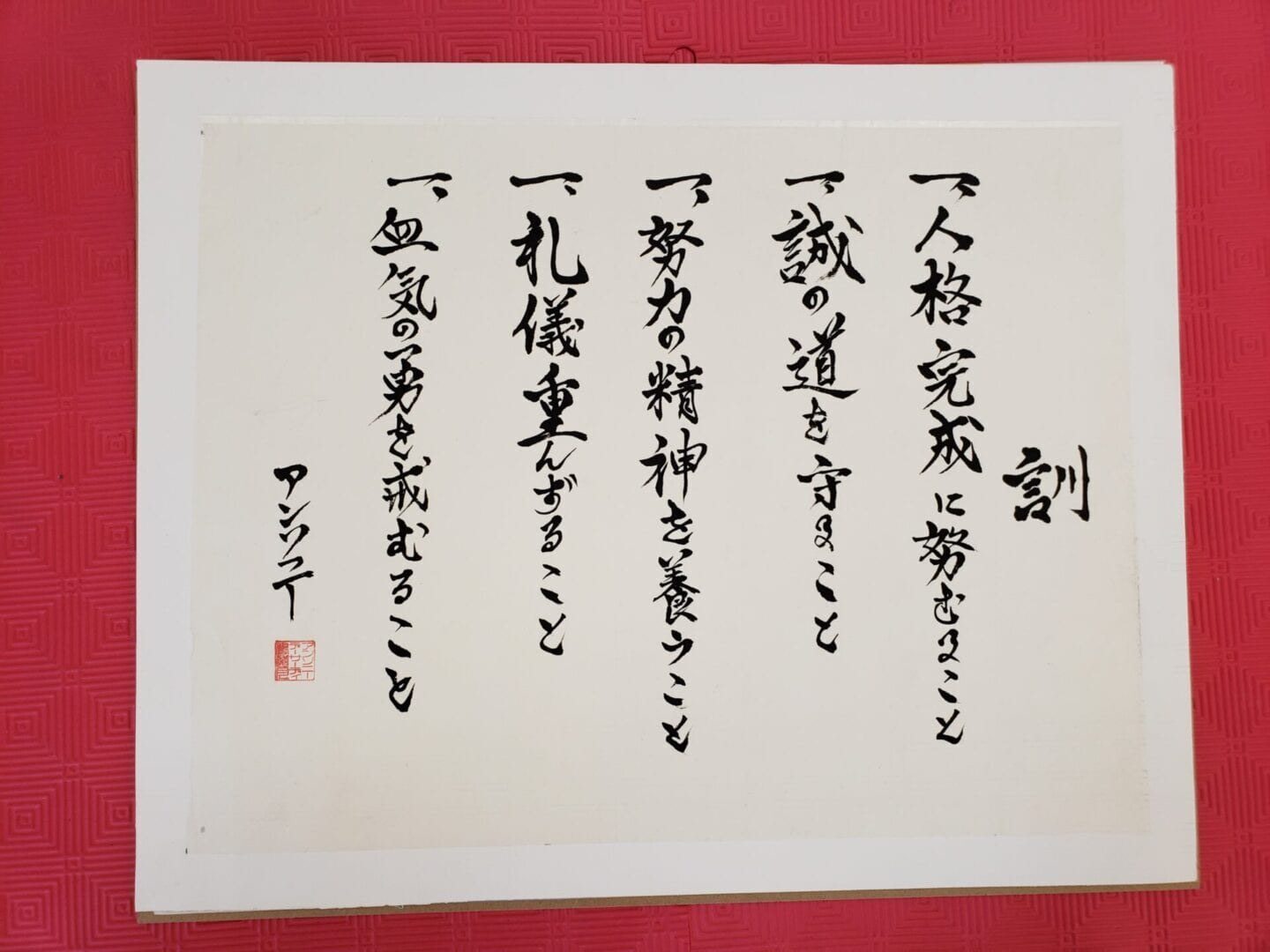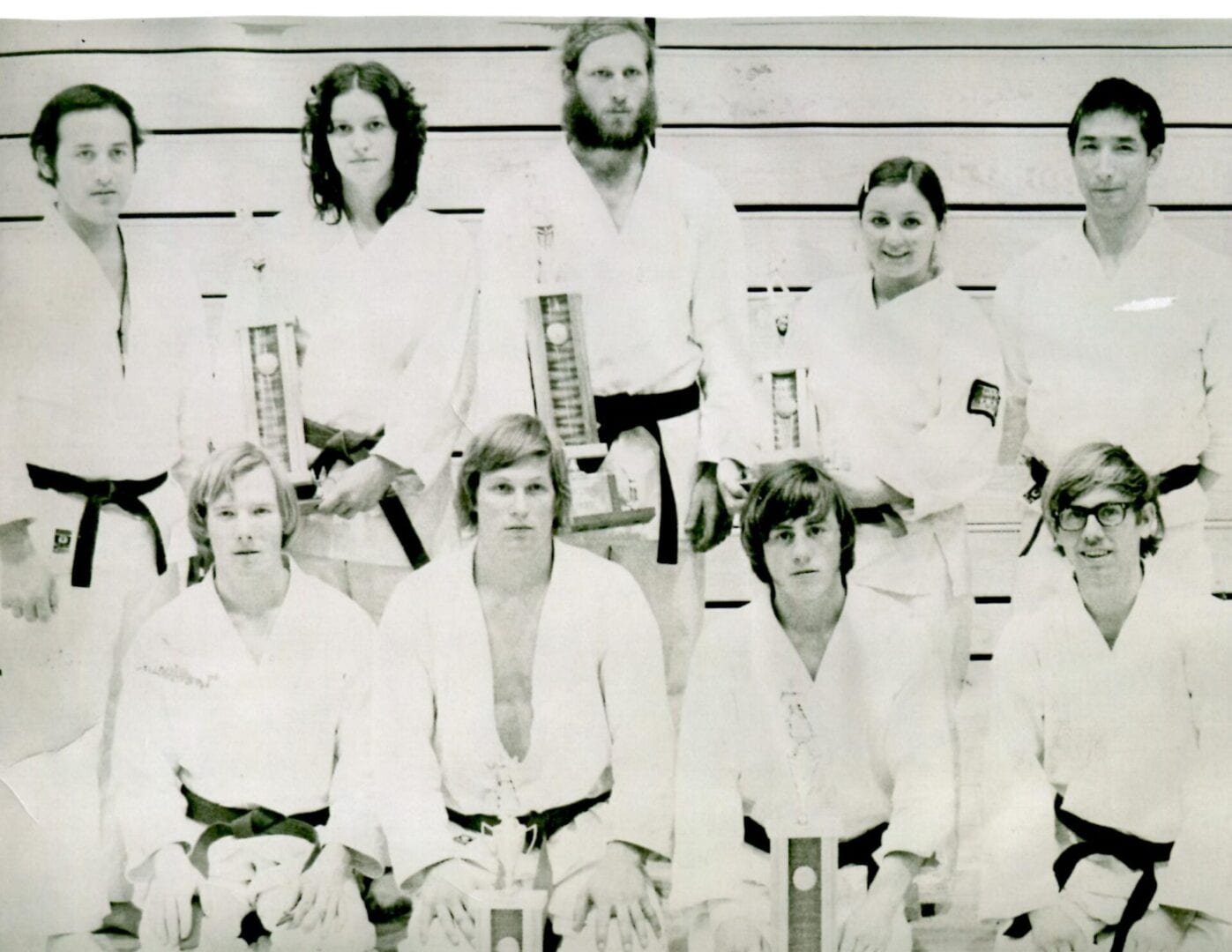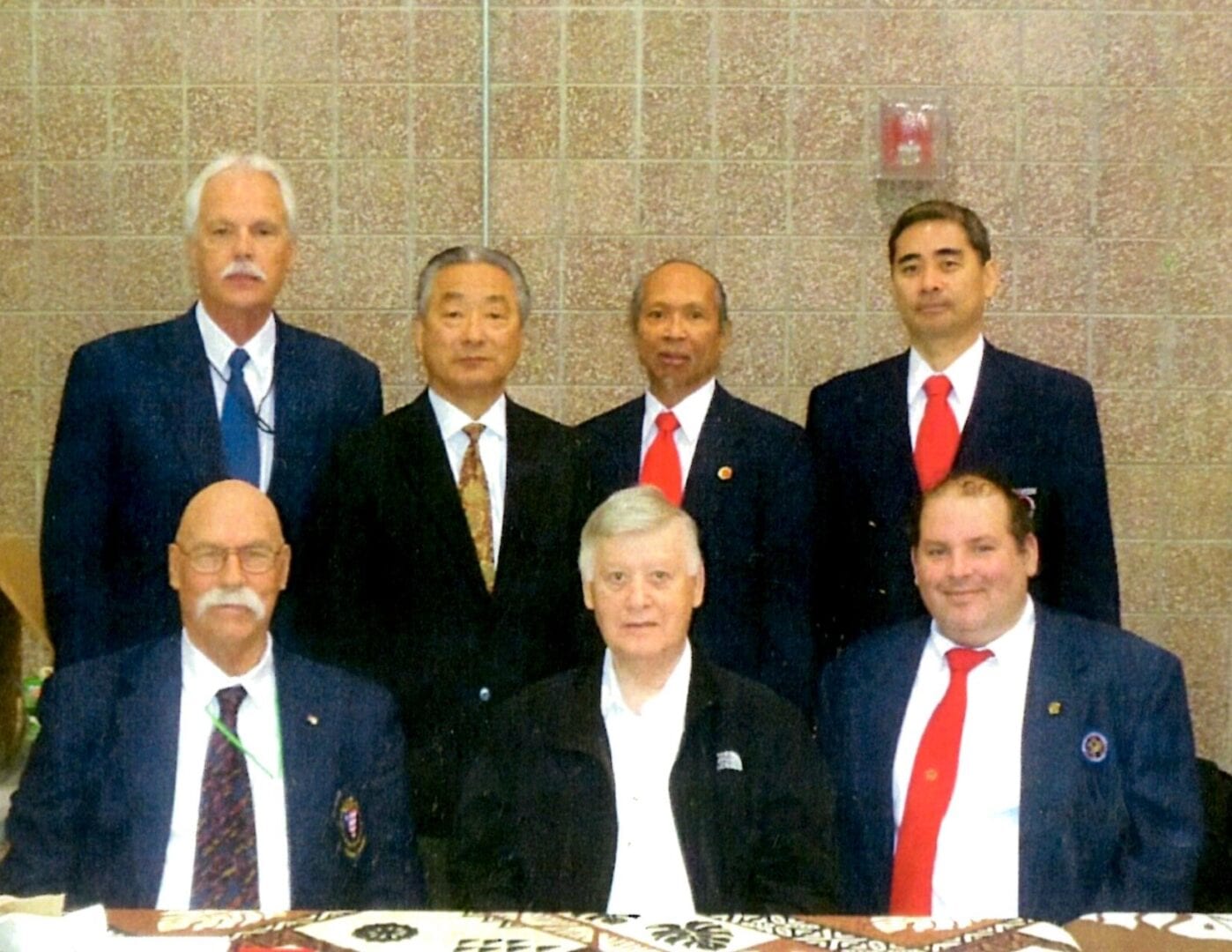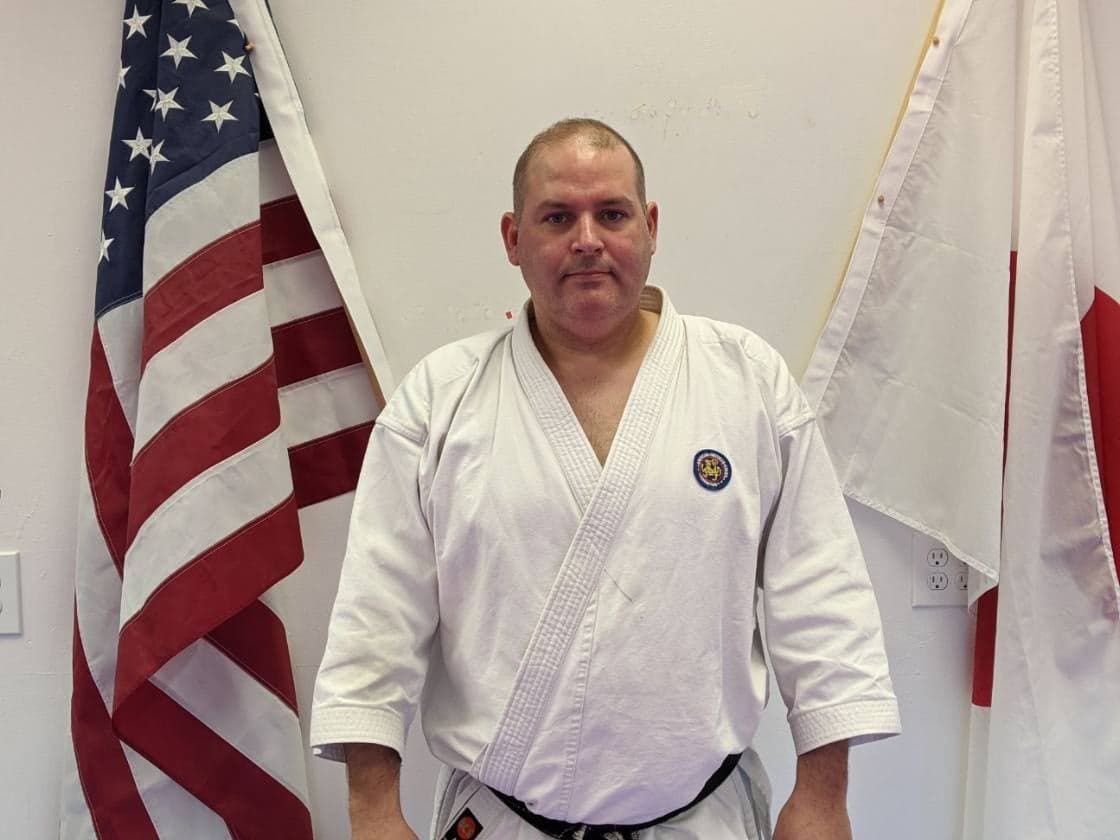Requirements for Each Shotokan Karate Color Belt
Philosophy
“The ultimate aim of karate lies not in victory or defeat, but in the perfection of the character of its participants”
– Gichin Funakoshi

Dojo Kun
It is traditional for every Dojo to have a set of principals that all students are expected to follow in their practice of karate and in their everyday lives. This Dojo Kun, or school code, is passed from instructor to instructor. There are several translation variations of the Shotokan Dojo Kun. In the ASKF the following is used:
Seek perfection of character!
Dojo Kun
Be Faithful!
Endeavor!
Respect others!
Refrain from violent behavior!
In Japanese, it is written as shown in this calligraphy. Japanese is read from right to left, and in this form up to down. The first line on the right says “Dojo Kun”, the rest are the five statements.
Click on the calligraphy to hear Dojo Kun in Japanese by Mr. Hiroyoshi Okazaki.
Master Funakoshi in the course of his 80 years of practicing karate devised this set of 20 precepts every karateka should learn in order to be successful in the practice of karate-do.
- Karate begins and ends with courtesy.
- There is no first attack in karate.
- Karate is an assistance to justice.
- Know yourself first. Then you can know others.
- Spirit before technique.
- You must release your mind
- Misfortune comes out of laziness.
- Karate is not just in the dojo.
- Karate is a lifelong training.
- Put Karate into everything you do.
- Karate, like hot water, will grow cool without constant heat.
- Do not think about winning. Think about not losing.
- Victory depends on your ability to tell vulnerable points from invulnerable ones.
- Move according to your opponent.
- Consider your opponent’s hands and legs as you would sharp swords.
- When you leave home, think that millions of opponents are waiting for you.
- Ready position is for beginners and natural position is for advanced students.
- Kata is one thing. Engaging in a real fight is another.
- Do not forget strength and weakness of power, expansion and contraction of the body, slowness and speed of techniques.
- Be thinking of a strategy at all times.
In his book, Karate-do, My Way of Life, Master Funakoshi closes with 5 rules he believes all students of karate must follow in the practice of karate-do (actually, he refers to 6 rules, but the 3rd rule is missing for some reason). Every student of karate is encouraged to discuss these rules with their teachers.
- “You must be deadly serious in training”.
- “Train with both heart and soul without worrying about theory”.
- “Avoid self-conceit and dogmatism”.
- “Try to see yourself as you truly are and try to adopt what is meritorious in the work of others”.
- “Abide by rules of ethics in your daily life, whether in public or private”.
Dojo Etiquette
Dojo and Class Etiquette
The dojo (training studio) is any place where instruction in Karate-do is conducted. Whether this is a studio owned by the sensei (instructor), a school gym, or a basement it should always be treated with respect.
There are some basic courtesies that should be observed in the Dojo. When entering or leaving the Dojo, the karateka should bow facing into the Dojo. This shows respect to the instructor, your fellow students, and your school. It is also customary to bow when you are dismissed by the sensei. In Asian culture, the bow is simply a way of saluting someone you respect.
A proper bow is done by standing with your feet together and your hands resting palm down on the sides of your thighs. You then bend calmly at the waist until your fingers are just touching the tops of your knees, then straighten up again.
Class will normally start with the students lining up in order of rank; highest to lowest; left to right. The highest-ranking student, called the dai sempai, will bow to the instructor and then direct the class to kneel (saiza). After everyone is kneeling, the dai sempai will start a minute of meditation (mokuso). During this time, the students should clear their minds of all distracting thoughts so they may better focus on the training. Then everyone will bow to the front (shomen ne rei), followed by a bow to the instructor (shomen ne sensei). This kneeling bow is performed by placing your hands on the floor in front of you and then bending at the waist until your head is nearly touching the floor.
In large classes, you may also have several assistant instructors who are lined up at a 90° angle to the left of the class. When there is an instructor line, the dai sempai will also instruct the class to show respect to the instructors. The command otaga ne rei will be given, at which time, the students should turn 45° to face the instructor line and bow to them.
Class ends with a similar ritual; however, in place of meditation, the dai sempai leads the class through a recitation on the Dojo kun. Each Dojo has a set of statements that reflect the school philosophy. This philosophy should guide students not only in their practice of Karate but also in their daily life.
Your sensei on occasion may opt to do an informal ritual to start or end the class. In the informal ritual, the bows are performed standing, and meditation or recitation are omitted.
Tournaments
Throughout the year, local, regional, and national tournaments are held. Most tournaments offer seminars on karate as well as the competitions. Tournaments are an excellent way to put the skills you learn to practical use. Karateka can participate in several different events. In all events, participants are grouped by age, gender, and skill in order to make the competition as fair as possible. This does not mean you won’t compete against someone older, stronger, or more experienced; in small events, there sometimes aren’t enough participants to break out into groups.
Beginner: White Belt, Yellow Belt, Orange Belt, Blue Belt; Intermediate: Green Belt, Purple Belt; Advanced: Brown Belt, Black Belt.
Division to be determined by the tournament Director by number of contestants and skill level (size is also considered in kumite). Gender may be mixed. Individual kata and kumite break down; skill levels Beginner (10-7 Kyu), Intermediate (6-4 Kyu), Advanced (3 kyu and up) age 7 and under, 8-10, 11-13, 14-17, 18-35, 35 and up.
Tournament officials reserve the right to split or combine divisions if there are too many or too few competitors in a division.
All participants must perform Japanese or Okinawan Kata. Contestants will be scored on their kata by a panel of 5 judges—the highest and lowest scores will not be added in unless a tie occurs, the lowest score will be added in and if still a tie, the highest scores will be added in and if still a tie then both contestants will perform second kata. In the advanced divisions, contestants will perform two kata with the scores for both kata to be added together to determine score.
This is an open division for all ages 5th Kyu and up. All participants must perform mandatory kata (Heien, Pinan, or Geisai) randomly selected by Chief Referee. Modified Repicharge will be used to determine the winner.
Divisions will be determined based on the number of participants. Participants must perform Japanese or Okinawan Kata. Modified Repicharge will be used in Team Kata.
The scorekeeper will announce scores, starting with the chief judge at the front and center of ring and proceeding clockwise around the ring. The high score and the low score will be dropped and the remaining three scores are totaled for the competitor's score. In case of a tie, the scorekeeper will add the low score back in. If still tied, the high score will be added. If still tied, the chief judge will ask the competitor to perform another kata.
Sparring between opponents. Karateka attempt to score points on their opponent by executing techniques with sun-dome, which means to stop the blow 1–3 centimeters from the point of contact. A half point is awarded for punches, strikes, or kicks that achieve sun-dome. A full point is awarded for combination techniques: a block followed by a successful attack or an attack that catches the opponent completely off-guard. Lower ranks participate in 3-point kumite called sanbon; the upper ranks do a 1-point kumite, called ippon.
Modified Repicharge will be used in Kumite with two-minute matches. Time will be running time which will only be stopped when directed by Chief Referee.
Brown and Black Belts will be Ippon (one point) Kumite. The bout is determined by scoring 1 Ippon or 2 Waza-ari (1/2 points). There will be four judges and a center referee, using flags.
Fourth Kyu and below will be Sanbon (3 point) Kumite. The bout is determined by scoring 3 Ippons or 6 Waza-ari or a combination of the two totaling Sanbon. This will have a referee, judge, and arbitrator (arbitrator is scorekeeper of the match and may be consulted for an opinion of the match.)
- Head.
- Face.
- Abdomen.
- Chest.
- Back.
Ippon is awarded for the following:
Good form, correct attitude, vigorous application, Zanshin, proper timing, and correct distance.
An Ippon may also be awarded for techniques deficient in one of the above criteria but which conform to the following;
- Jodan Kicks—kicks to the head.
- Successfully scoring at the precise moment the opponent attacks.
- Sweeping/deflecting an attack and scoring to the unguarded back of the opponent.
- Delivering a combination technique, the individual components of which each score on their own right.
- “Perfect technique” – superbly executed technique to legal target area delivered with kiai.
Waza-ari is awarded for a technique almost comparable to that needed to score an Ippon.
Ippon is decisive; a technique that could finish the fight and Waza-ari is a technique that could have hampered the opponent’s ability to fight.
The following is forbidden:
- Techniques to the throat.
- Excessive Contact.
- Attacks to the spine, groin, joints, or instep.
- Attacks to the face with open hand.
- Dangerous throws.
- Uncontrollable techniques ( i.e. spinning hook kick, ax kick, spinning back fist ).
- Repeat direct attacks to legs or arms.
- Wasting time.
- MUBOBI - display a lack of regard for personal safety.
- Feigning of injury in order to gain advantage.
Penalties/disqualifications may be given by chief judge in varying degrees depending on the seriousness of the offense and if repeated. This may be a warning, ½ point, full point, and or disqualification but does not necessarily start at lowest level, all at the discretion of the chief judge.
This relates to a situation where a contestant’s foot or part thereof moves outside the competition area, unless pushed out by an opponent. The following are the different levels of Jogai penalties (Sanban/Ippon):
First Jogai – warning/warning
Second Jogai – 1/2 point awarded to the opponent/second warning
Third Jogai – Full point awarded to opponent/Match given to opponent
Fourth Jogai – Match given to the opponent/Not applicable
No technique will be scored if it is delivered when the two contestants are outside the competition area. However, if one the competitors is outside the competition area and the opponent delivers as effective technique whilst still inside the competition area and before the referee calls “Yame” or “Stop”, the technique will be scored
Simultaneous techniques delivered by both contestants shall not score.
Term
Referee Signal
Explanation
Aka
Always the competitor to the head judge’s right-hand side whether it is in kumite or in mandatory kata. Red Shiro
Always the competitor to the head judge’s left-hand side whether it is in kumite or in mandatory kata. White Waza-Ari
Referee reaches up to his opposite (non-scoring) shoulder and extends his arm down towards the side that has scored. Half-Point Ippon
Referee reaches down to his opposite (non-scoring) hip and extends his arm up towards the side that has scored. Full-Point No Kachi
Same action as Full Point. Winner Jogai
Outside match area penalty. Referee uses two hand signals with this announcement. First, the referee announces Red or White. Then, he points (with his index finger) to the match boundary on the side of the offender and then points to the offender announcing the appropriate penalty if needed. He then awards any required points to the other competitor. The first time a competitor goes out of bounds, a warning is called. The second time, another warning is called, and the other person receives a Half Point. The third time, another warning is called, and the other person receives a Full Point. That would be the end of the match in Ippon Kumite. The fourth time, another warning is called, and the other competitor automatically wins the match. Out of Bounds Torimasen
Referee crosses arms over chest, then uncrosses and holds arms out from body with palms downward. Unacceptable scoring technique Hikiwake
Referee crosses arms over chest, then uncrosses and holds arms out from body with palms upward.



